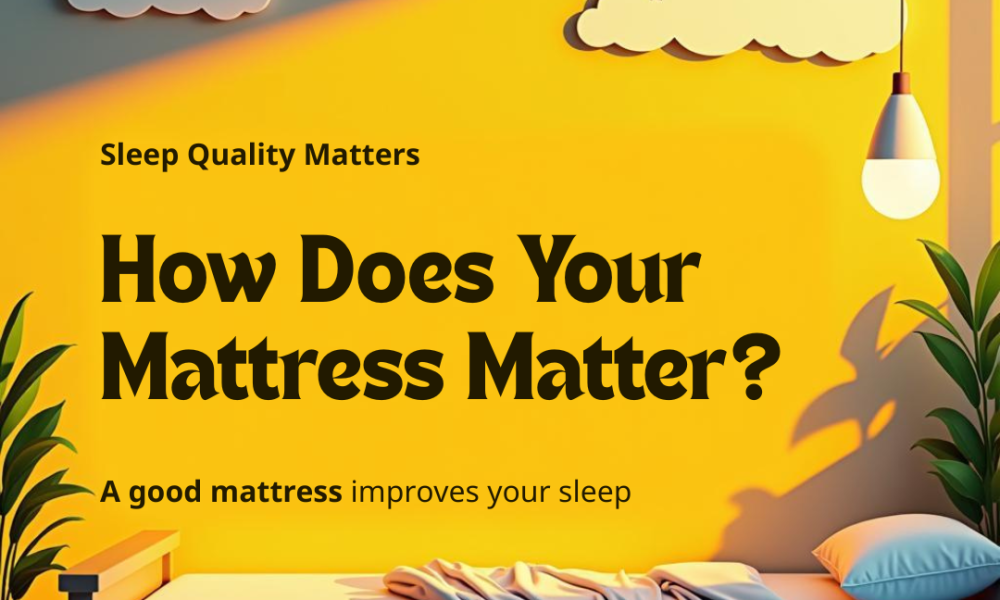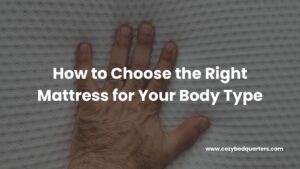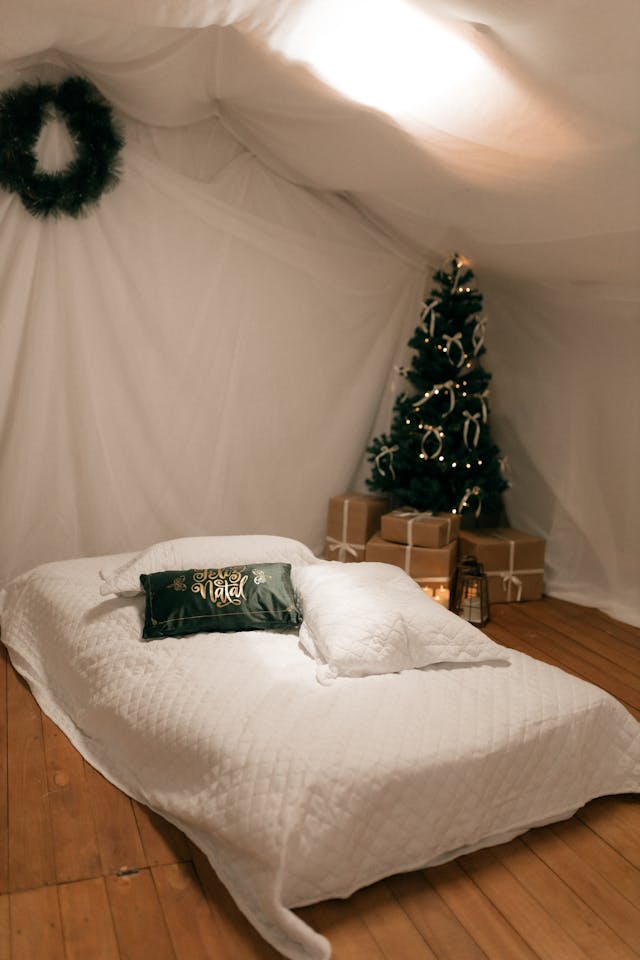How Your Mattress Affects Sleep Quality: The Real Reason You’re Not Rested
Struggling with poor sleep? It might not be stress or screen time—it could be your mattress. Learn how your mattress affects sleep quality and what to do about it.
Ever wake up more tired than when you went to bed? Tossing and turning all night, wondering why you just can’t seem to get good sleep? The culprit might not be your stress levels or late-night snacks—it could be your mattress. In fact, understanding how your mattress affects sleep quality is essential to better rest and overall health. To dive deeper into temperature’s role, see our guide on sleep temperature regulation.
A mattress isn’t just a big rectangle you crash on at night. It’s the foundation of your sleep—and let’s face it, your sleep affects everything. If your bed isn’t doing its job, your whole day can feel like it’s stuck in first gear.
In this guide, we’ll break down how your mattress affects sleep quality, signs it’s time for an upgrade, and how to choose a better one.

Key Takeaways on How Your Mattress Affects Sleep Quality
- A mattress directly impacts spinal alignment, pressure relief, and temperature regulation.
- Common red flags include aches, dips, overheating, and better sleep elsewhere.
- Choosing a mattress should match your sleep position and personal preferences.
- Material matters—memory foam, hybrid, latex, and air-adjustable options all perform differently.
- Caring for your mattress properly extends its comfort and longevity.
- Understanding how your mattress affects sleep quality helps you make smarter sleep investments.
Why Your Mattress Matters for Sleep Quality
If you’re getting the recommended 7–9 hours a night, that’s about a third of your life. Shouldn’t that time be comfortable, supportive, and, well… dreamy? Let’s explore how your mattress affects sleep quality and why it’s more than just a place to crash.
What Makes a Mattress Sleep-Friendly?
- Spinal Alignment – A good mattress keeps your back and neck in a neutral position.
- Motion Isolation – If your partner tosses like a pizza, you shouldn’t feel every flip.
- Pressure Relief – Your shoulders and hips will thank you when they’re gently cradled.
- Temperature Control – If you’re waking up in a sweat, it might be the mattress.

🛏️ Explore more bed materials and their durability to find the right support and feel for your sleep style.
Signs Your Mattress is Hurting Your Sleep
If you’re not waking up refreshed, it might be time to reassess how your mattress affects sleep quality. Your body sends signals when something’s off.
Red Flags to Watch For
- You wake up stiff or achy.
- You notice dips or lumps.
- You wake up hot and sweaty.
- You’re constantly tossing and turning.
- You sleep better anywhere else—even at the in-laws’!
According to WebMD, waking up with soreness or allergies could point to a mattress issue.
How to Choose the Right Mattress for Your Body
Picking the right mattress isn’t just about firmness. It’s about you. Your sleep style, body type, and temperature preferences all play a role.
Best Fit by Sleeping Position
- Back Sleepers → A medium-firm bed keeps things supported but comfy.
- Side Sleepers → You want some give to cushion your shoulders and hips.
- Stomach Sleepers → Go firm to keep your spine in line.
- Combo Sleepers → A hybrid mattress adapts to movement and changing positions.
Firmness Scale Breakdown
- Soft (3–4/10) – Plush and cushiony; ideal for smaller bodies or side sleepers.
- Medium (5–6/10) – The “Goldilocks” zone for most sleepers.
- Firm (7–9/10) – Great for support and alignment, especially for stomach sleepers.
💤 Discover the Best Bedding Types and Purchasing Guide for You

What Mattress Materials Make the Biggest Difference?
Ever laid on a mattress that felt like a warm cloud—or a sweaty rock? That’s the material talking.
Popular Mattress Types
- Memory Foam – Excellent pressure relief, great for motion isolation, but can sleep warm.
- Innerspring – Classic bounce and airflow, but not always the softest.
- Hybrid – The best of both worlds: foam comfort + spring support.
- Latex – Breathable, natural, and eco-friendly with a bit more bounce.
- Air Adjustable – Ideal if you and your partner need different firmness levels.
Sleep Foundation reports that upgrading to a better mattress improves sleep satisfaction and reduces back pain.
🌡️ Check out the best bedding materials for hot sleepers to complement your mattress choice.
Smart Shopping Tips: What to Look for in a Mattress
- Try Before You Buy – Look for 100-night trials and in-store testing if possible.
- Check the Warranty – A good mattress should come with at least a 10-year promise.
- Look for Cooling Features – Gel-infused foam, open coils, and breathable covers help hot sleepers.
- Think About Motion Transfer – Minimize sleep disruption from partner movement.
- Budget Wisely – Great mattresses can be found between $500–$2,500.
Consumer Reports mattress buying guide
How to Make Your Mattress Last (and Stay Cozy for Years)
Mattress TLC Tips
- Use a Mattress Protector – Keeps sweat, dust, and stains at bay. Learn how to clean your mattress properly.
- Rotate Regularly – Every 3–6 months to avoid dips.
- Let It Air Out – Don’t make the bed right away; let it breathe.
- Vacuum Occasionally – Keep it clean and allergen-free.

FAQ
How do I know if my mattress is the cause of poor sleep?
If you experience aches, overheating, or sleep better in other beds, your mattress may be the issue.
How often should I replace my mattress?
On average, every 7–10 years depending on material and condition.
What’s the best mattress for back pain?
A medium-firm hybrid or memory foam mattress often provides the best support and relief.
Final Thoughts: Sleep Better, Live Better
When you sleep better, everything feels better—your mood, your energy, your ability to take on the day. And it all starts with what you’re sleeping on.
If your mattress is sagging, hot, or just not cutting it anymore, don’t wait. You deserve sleep that leaves you refreshed, not frustrated. Knowing how your mattress affects sleep quality can be a game changer.
- 🛏️ See our breakdown of bedding materials and benefits
- 🧵 What thread count should you look for in sheets?
🌙 Upgrade your mattress—and wake up to better mornings.
Related reading from Cozy Bed Quarters
- Your Ultimate Guide on How to Clean a Bed Mattress
- Bedroom Bliss: Exploring Bed Materials for Comfort and Durability
- Discover the Best Bedding Types and Purchasing Guide for You
Other reading we found popular
- How Sleep Changes with a New Mattress – Sleep Foundation
- Mattress Guides – Eachnight
- Best Mattresses Reviewed – The Spruce
- Architectural Digest’s Picks for Best Mattresses























